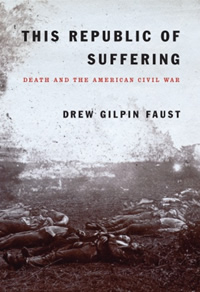Book Notes
 Drew Gilpin Faust, This Republic of Suffering; Death and the American Civil War (New York: Alfred A. Knopf, 2008), 346pp.
Drew Gilpin Faust, This Republic of Suffering; Death and the American Civil War (New York: Alfred A. Knopf, 2008), 346pp.
The Civil War meant many things to different people, but to everyone in America at the time it meant death. Mass death on an unprecedented and unimaginable scale. About three million Americans fought in the war. Approximately 620,000 of them died, a number "equal to the total American fatalities in the Revolution, the War of 1812, the Mexican War, the Spanish-American War, World War I, World War II, and the Korean War combined" (italics mine). That's a death rate of about 2% of those who fought, which today would equal about six million American dead. Over half of the Civil War Dead remain unidentified. Nor do these combatant deaths include "collateral" civilian deaths.
Drew Gilpin Faust, president of Harvard, does not merely quantify this carnage. She explores it from numerous and different angles. To each of her eight chapters she assigns a single word. Dying examines the nature of the so-called Good Death, and shows how people wondered if there could be any meaning, whether political or religious, in so much slaughter. Killing was "a problem to overcome" since human conscience, religion, reason, and culture all inhibited the idea of taking another's life. But kill they did, given sufficient rationalizations and justifications. Burying a half million bodies (and 1.5 million horses and mules) in primitive conditions seems unimaginable in retrospect, and it was, while Naming the dead shows how more than 50% of the casualties not only lost their lives but their identities. Realizing considers the practical impact of the war on non-combatant civilians, and the rites, rituals, and dress they adopted to channel their grief. Belief and Doubt turns to theodicy, where the north could at least appeal to vindication and victory while the confederate south appealed to notions of abandonment and punishment. Others like Mark Twain, Herman Melville and Emily Dickinson invoked secular and tragic irony. The final two chapters on Accounting and Numbering explore how the nation fulfilled its obligations to the dead by establishing national cemeteries and federal legislation for the Union dead, and, in the south which was ignored and neglected by the government, similar efforts by citizen groups. 303,536 Union soldiers were eventually disinterred and reburied in national cemeteries.
Faust quotes heavily from primary source material like letters, sermons, diaries, newspaper articles, advertisements, death records, grave stones, and the like. She retains their florid language, bad grammar, misspellings, and creative expressions. She does an especially good job of noting the roles played by women citizens bereft of their men and black soldiers who fought nobly. Over fifty photographs (a new technology at the time) and illustrations, along with fifty pages of footnotes, complete the book. This book is not only a work of pain-staking historical research and sober philosophic reflection; it's a fitting labor of love that honors the memory of those who died in America's deadliest war.


